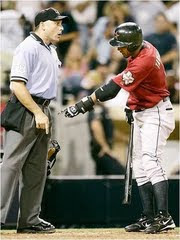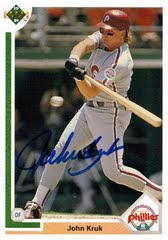My always interesting college Anna McDonald posed an interested thought earlier today about the NL and the use of a DH in the World Series. Implicitly, she posed the question of whether the DH was an advantage or disadvantage for NL teams.
En point, I rant accordingly, and conclude that it does.
The average NL team's starting line up consists of eight hitters and a pitcher who also bats. The "ninth" hitter for NL teams is a bench player. Given the fact that pitchers generally cannot hit and that bench players see limited and infrequent playing time, an NL team trying to optimize their starting lineup has little incentive to "pimp out" the bench. Rather, an NL team has an incentive to focus their resources on maximizing the talents of their other eight starting hitters. A team's batting resources, therefore, will be primarily focused on eight hitters, with the residual going to the bench -- which optimally is designed to be deep rather than feature a "stud."
On the other hand, the AL has seven starting hitters (thanks to the DH) and hence has an incentive to invest in that ninth hitter, who is essentially a "batting specialist." There is less of a focus on the "deep bench," instead finding an effective ninth hitter to slot into the daily line up.
Thus, comparing the AL to the NL, one notes a clear difference in strategy due to the league's traditional lineup composure: the NL has an incentive to maximize the primary eight hitters and diversify the remaining resources amongst the bench, while the AL has an incentive to spend on nine hitters (creating a polarity between the NL's 9th guy and the NL's 9th guy).
So what is the point?
Well, this explains, in part (the other part being sample size), why the average NL DH (as derived from interleague play) tends to function less effectively than their AL counterpart. In 2010, for example, the average major league DH hit for a .699 OPS, while the average AL DH hit for a .757 OPS.
in 2010. NL DH's hit for a .649 OPS. This makes sense because NL teams focus on bench depth, not having a best "#10 hitter", whereas the AL invest directly in their DH (he plays regularly). Meanwhile, the average NL DH only hit for a .649 OPS. This disparity is also observable in 2008, 2007, 2006, 2005, and so on (2009 seems to be an exception...).
This of course, noting the above incentive structure, make sense. NL teams, who use pinch hitters more frequently than a "ninth hitter" have a greater incentive to diversify the bench than polarize said resources in a "reliable" ninth hitter. Meanwhile, AL teams have a pervasive need for a "reliable" ninth hitter. Furthermore, the AL has a hitting specialist whose sole value derives from his batting skills, whereas the NL's ninth, tenth and eleventh batters all derive value not just from batting, but also playing the field. This is because 1) there is no DH in the NL and because a fielding pinch hitters gives an NL manager greater lineup flexibility. Thus, it makes more sense that the AL's DH would be of higher quality than the average NL DH.
In terms of the World Series, therefore, it is the AL who inherently gains the advantage through the use of the DH. Whereas both teams may have equally poor hitting pitchers, the AL teams tend to have the clear upper hand in terms of ninth hitters. Of course, this assumes that the distribution of potential talent between teams is uniform, which is ridiculous to say the least, but it indicates that in a vacuum, between two teams with equal access to talent, the AL has an upper hand at the plate when they play at home.
Or maybe none of this makes a lick of sense. That is also entirely plausible.
skip to main |
skip to sidebar

That pitch accounted for 15% of Jimmy Rollin's OBP for 2006

Is my .320 batting average giving you a boner?

That Darren Erstad was a punter in college??

John Kruk struck out in this AB

Statistically speaking, sacrifice bunts are counter-productive

Best signature ever

Written by none other than Joe Morgan
Buy Tickets!
Gophers Fans, Buy Gophers Tickets including Gopher Basketball Tickets today. Check out Williams Arena Tickets and buy Minnesota Gophers Basketball Tickets today.
The 25 Greatest Movies Of The Past 25 Years
GOI Fantasy Sports Analysis
Contributors
- Sexy Rexy
- The 'Bright' One
- David "MVP" Eckstein
- Cubsfan4evr
Board Bets
Search GOI, Fangraphs, And The Hardball Times For Content
Local Blogs We're Reading
National Blogs We're Reading
Finding Stats
Faceball

That pitch accounted for 15% of Jimmy Rollin's OBP for 2006
Ump Bump

Is my .320 batting average giving you a boner?
Did You Know...

That Darren Erstad was a punter in college??
Little Known Fact

John Kruk struck out in this AB
The Great Runs Expectancy Chart

Statistically speaking, sacrifice bunts are counter-productive
Pete Rose Baseball

Best signature ever
The Most Ironic Book Ever Written

Written by none other than Joe Morgan
Blog Archive
-
▼
2010
(609)
-
▼
November
(45)
- Game Of Inches Football Results: Week Twelve
- A Quick Reminder Of Why I Hate Dusty Baker
- DME's Top 20 Fantasy First Basemen For 2011
- TBO and Sexy Rexy Reunite For A Long Awaited Podcast
- Stolen Goods: How far will $11 get you at Taco Bell
- Box Score Tonight: Week Twelve/Late Games Edition
- Blake Griffin: The Narrow World of Sports
- DME's Top 20 Fantasy Catchers For 2011
- Box Score Tonight: Thanksgiving Day Edition
- Game of Inches Football Results: Week 11
- Sexy Rexy's Fantasy Advice: Rankings For Week Twelve
- I feel cheated like Eva Longoria. Zing!
- Matt Cassel vs. Mark Sanchez
- Box Score Tonight: Week Eleven/Late and Night Game...
- Odds On End of The Year NFL Winner
- The Dynasty Of Jimmie Johnson
- Box Score Tonight: Week Eleven/Early Games Edition
- Blake Griffin Had 3 Best Dunks of Year in One Game
- Maybe Not Every Sport Should Play At Wrigley
- Hamilton or Cabrera for MVP?
- Joe Morgan DFAed, What Now FJM?
- Sexy Rexy's Fantasy Advice: Rankings For Week Eleven
- ESPN Has Officially Run Out of Ideas
- Is Cliff Lee A Top Five Starting Pitcher?
- Stolen Goods: The wOBA Calculator
- Roy Halladay Unanimously Win Cy Young
- Game Of Inches Football Results: Week Ten
- Quick ROY Rant
- How Safe Is Your Coach's Job?
- Pick One: The Top 30 FA Landing Spots
- Sexy Rexy's Fantasy Advice: Rankings For Week Ten
- Game Of Inches Football Results: Week Nine
- Worthless Sports Predictions: DME's Top 20 FA Land...
- ESPN Has Actually Fired Joe Morgan
- New Podcasts Up!
- The Top 20 Film Soundtracks Of All Time
- The Greatest ______ Of This Decade
- Sexy Rexy as Kenny Powers
- New Podcasts Up!
- Sexy Rexy's Fantasy Advice: Rankings For Week Nine
- Things I Got Right (And Wrong)
- Hottest Rap of 2010
- Defending Tony Romo
- Game Of Inches Football Results: Week Eight
- A Quick Rant About The NL DH
-
▼
November
(45)
2 comments:
College?
the AL team has the advantage in both leagues. the only thing they may lack is strategy in an NL park, but a halfway decent manager should be able to manage a double switch
Post a Comment